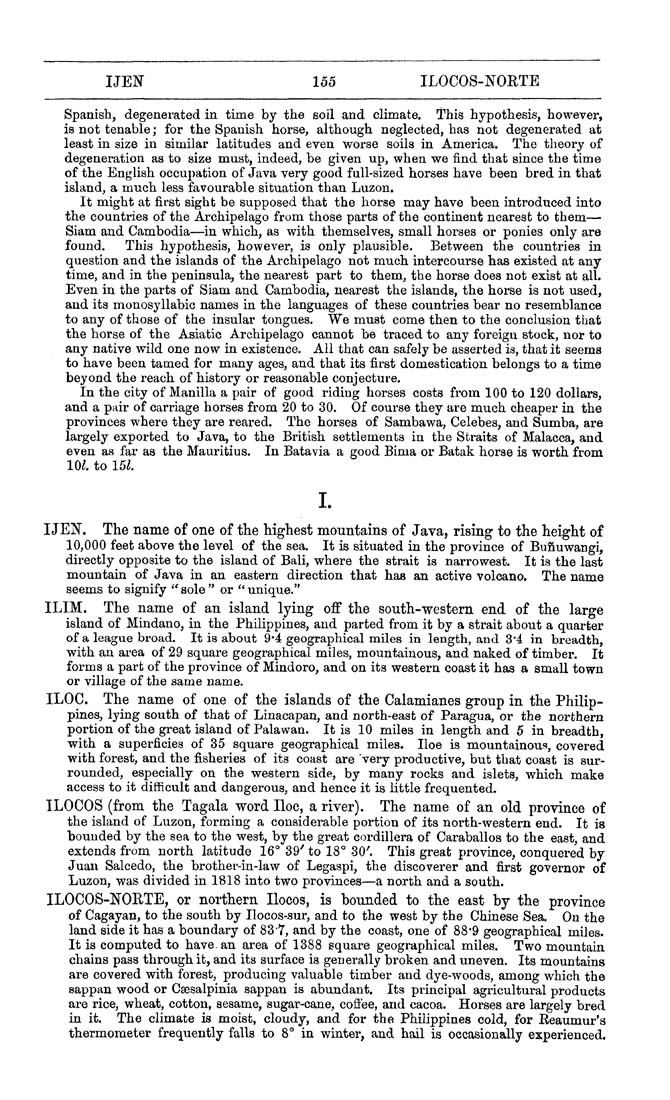IJEN 155 ILOCOS-NORTE
Spanish, degenerated in time by the soil and climate. This hypothesis, however,
is not tenable; for the Spanish horse, although neglected, has not degenerated at
least in size in similar latitudes and even worse soils in America. The theory of
degeneration as to size must, indeed, be given up, when we find that since the time
of the English occupation of Java very good full-sized horses have been bred in that
island, a much less favourable situation than Luzon.
It might at first sight be supposed that the horse may have been introduced into
the countries of the Archipelago from those parts of the continent nearest to them—
Siam and Cambodia—in which, as with themselves, small horses or ponies only are
found. This hypothesis, however, is only plausible. Between the countries in
question and the islands of the Archipelago not much intercourse has existed at any
time, and in the peninsula, the nearest part to them, the horse does not exist at all.
Even in the parts of Siam and Cambodia, nearest the islands, the horse is not used,
and its monosyllabic names in the languages of these countries bear no resemblance
to any of those of the insular tongues. We must come then to the conclusion that
the horse of the Asiatic Archipelago cannot be traced to any foreign stock, nor to
any native wild one now in existence. All that can safely be asserted is, that it seems
to have been tamed for many ages, and that its first domestication belongs to a time
beyond the reach of history or reasonable conjecture.
In the city of Manilla a pair of good riding horses costs from 100 to 120 dollars,
and a pair of carriage horses from 20 to 30. Of course they are much cheaper in the
provinces where they are reared. The horses of Sambawa, Celebes, and Sumba, are
largely exported to Java, to the British settlements in the Straits of Malacca, and
even as far as the Mauritius. In Batavia a good Bima or Batak horse is worth from
10^. to 15^.
I.
IJEN. The name of one of the highest mountains of Java, rising to the height of
10,000 feet above the level of the sea. It is situated in the province of Bnfiuwangi,
directly opposite to the island of Bali, where the strait is narrowest. It is the last
mountain of Java in an eastern direction that has an active volcano. The name
seems to signify " sole " or " unique."
ILIM. The name of an island lying o& the south-western end of the large
island of Mindano, in the Philippines, and parted from it by a strait about a quarter
of a league broad. It is about 9*4 geographical miles in length, and 3*4 in breadth,
with an area of 29 square geographical miles, mountainous, and naked of timber. It
forms a part of the province of Mindoro, and on its western coast it has a small town
or village of the same name.
ILOC. The name of one of the islands of the Calamianes group in the Philip¬
pines, lying south of that of Linacapan, and north-east of Paragua, or the northern
portion of the great island of Palawan. It is 10 miles in length and 5 in breadth,
with a superficies of 35 square geographical miles. Iloe is mountainous, covered
with forest, and the fisheries of its coast are very productive, but that coast is sur¬
rounded, especially on the western side, by many rocks and islets, which make
access to it difficult and dangerous, and hence it is little frequented.
ILOCOS (from the Tagala word Hoc, a river). The name of an old province of
the island of Luzon, forming a considerable portion of its north-western end. It is
bounded by the sea to the west, by the great cordillera of Caraballos to the east, and
extends from north latitude 16° 39' to 18° 30'. This great province, conquered by
Juan Salcedo, the brother-in-law of Legaspi, the discoverer and first governor of
Luzon, was divided in 1818 into two provinces—a north and a south.
ILOCOS-NORTE, or northern Ilocos, is bounded to the east by the province
of Cagayan, to the south by Ilocos-sur, and to the west by the Chinese Sea. On the
land side it has a boundary of 83 7, and by the coast, one of 88*9 geographical miles.
It is computed to have, an area of 1388 square geographical miles. Two mountain
chains pass through it, and its surface is generally broken and uneven. Its mountains
are covered with forest, producing valuable timber and dye-woods, among which the
sappan wood or Csesalpinia sappan is abundant. Its principal agricultural products
are rice, wheat, cotton, sesame, sugar-cane, coffee, and cacoa. Horses are largely bred
in it. The climate is moist, cloudy, and for the Philippines cold, for Reaumur's
thermometer frequently falls to 8° in winter, and hail is occasionally experienced.
|








